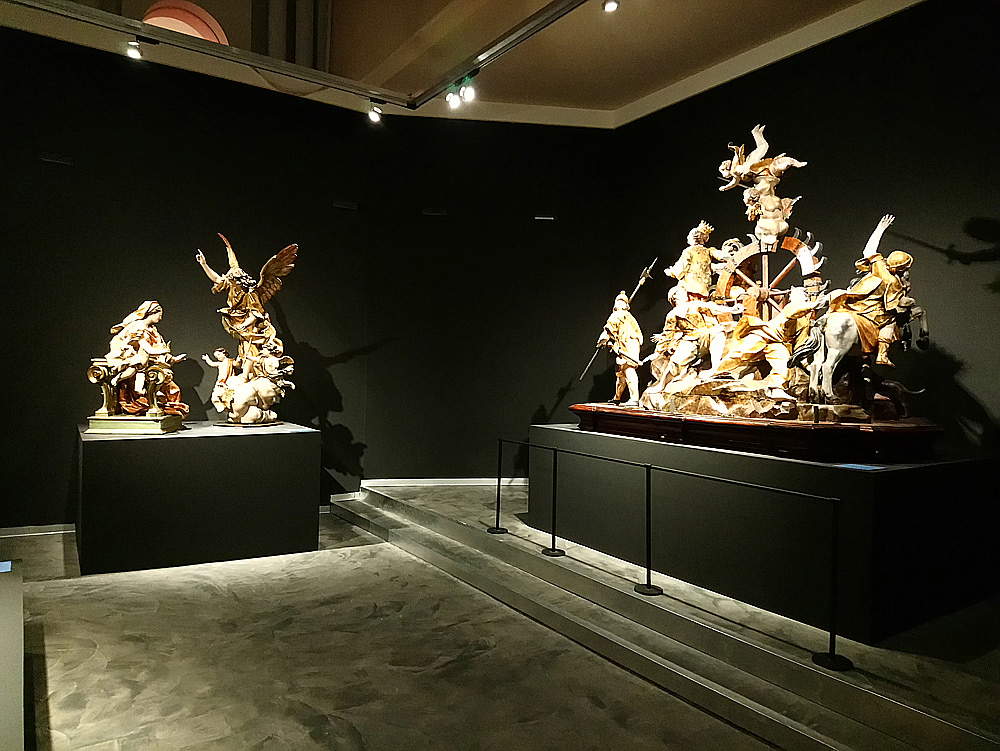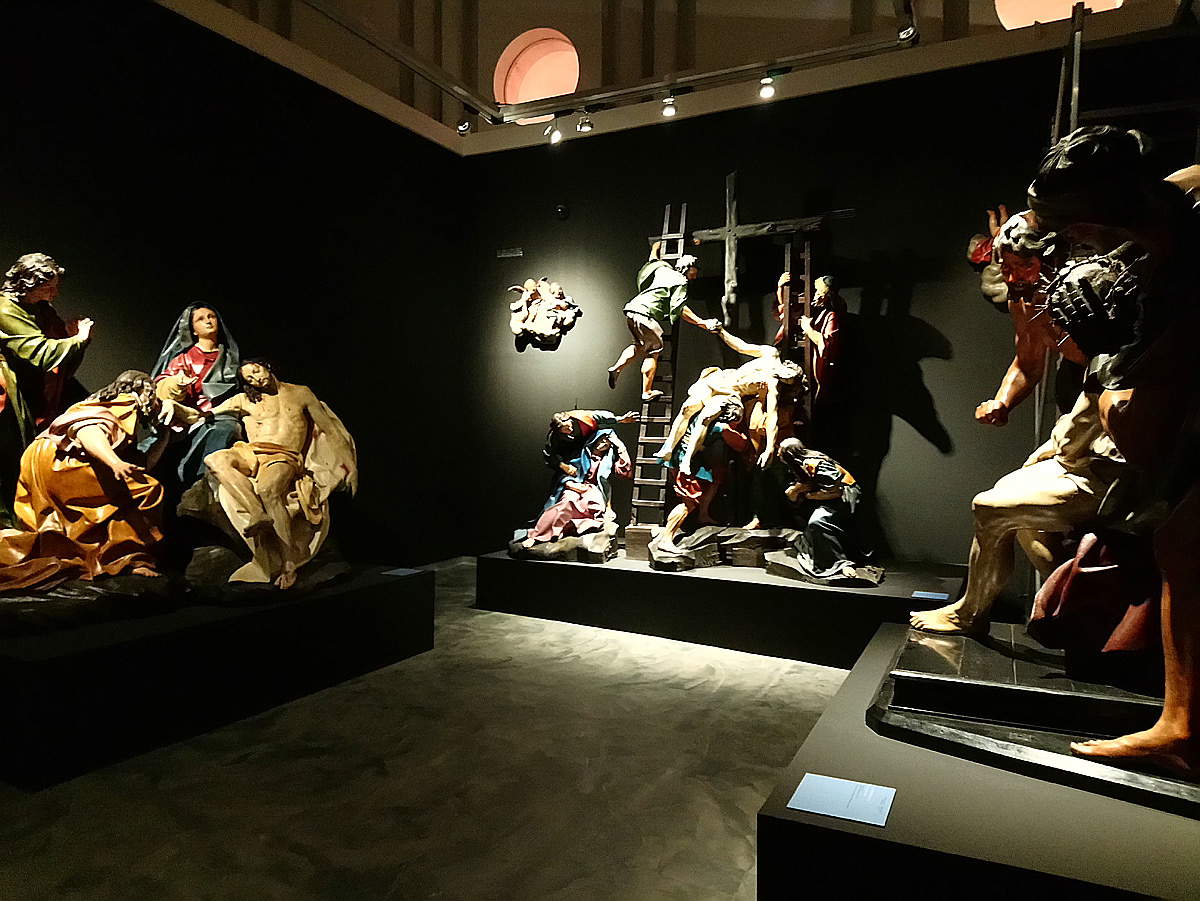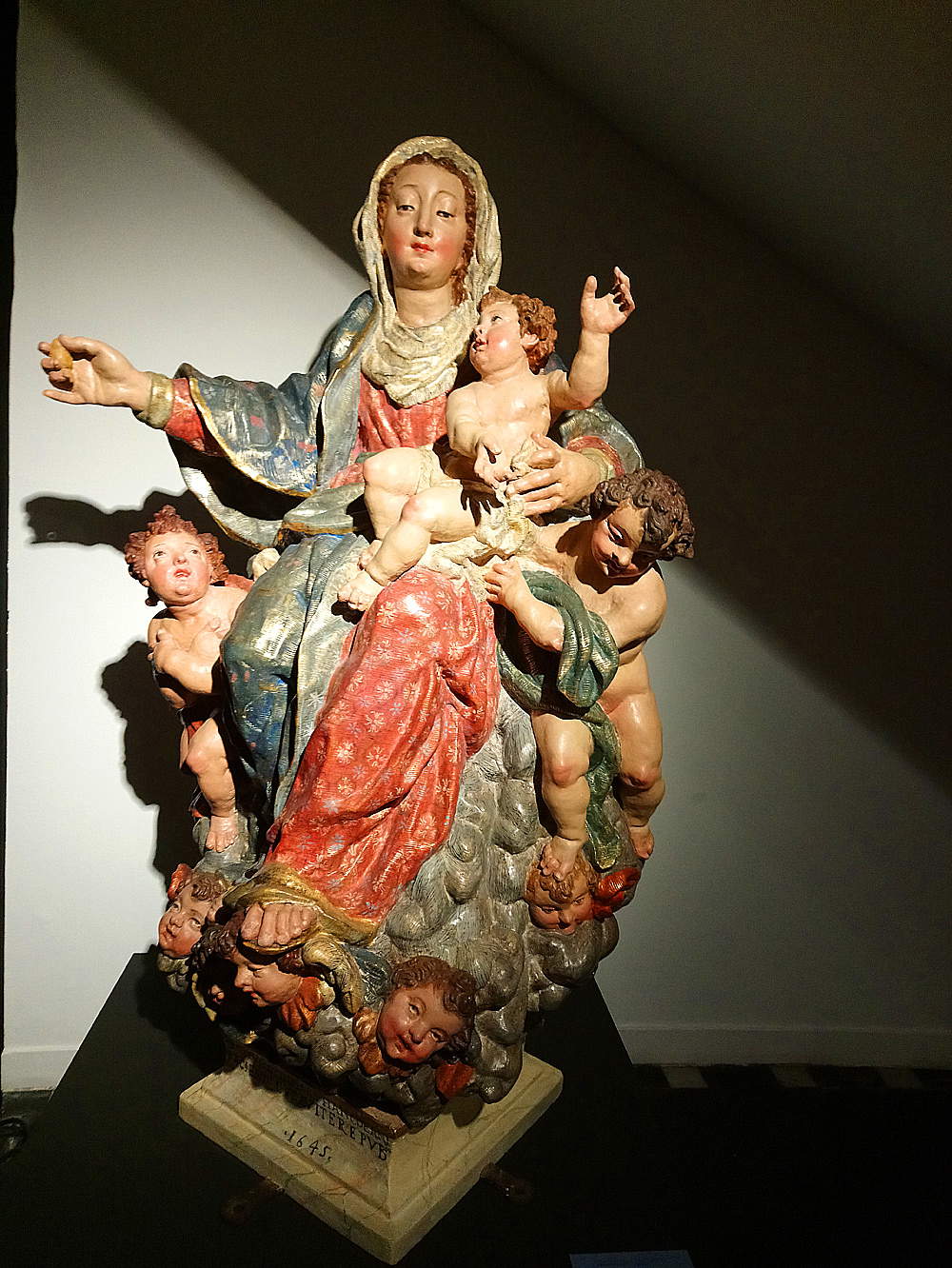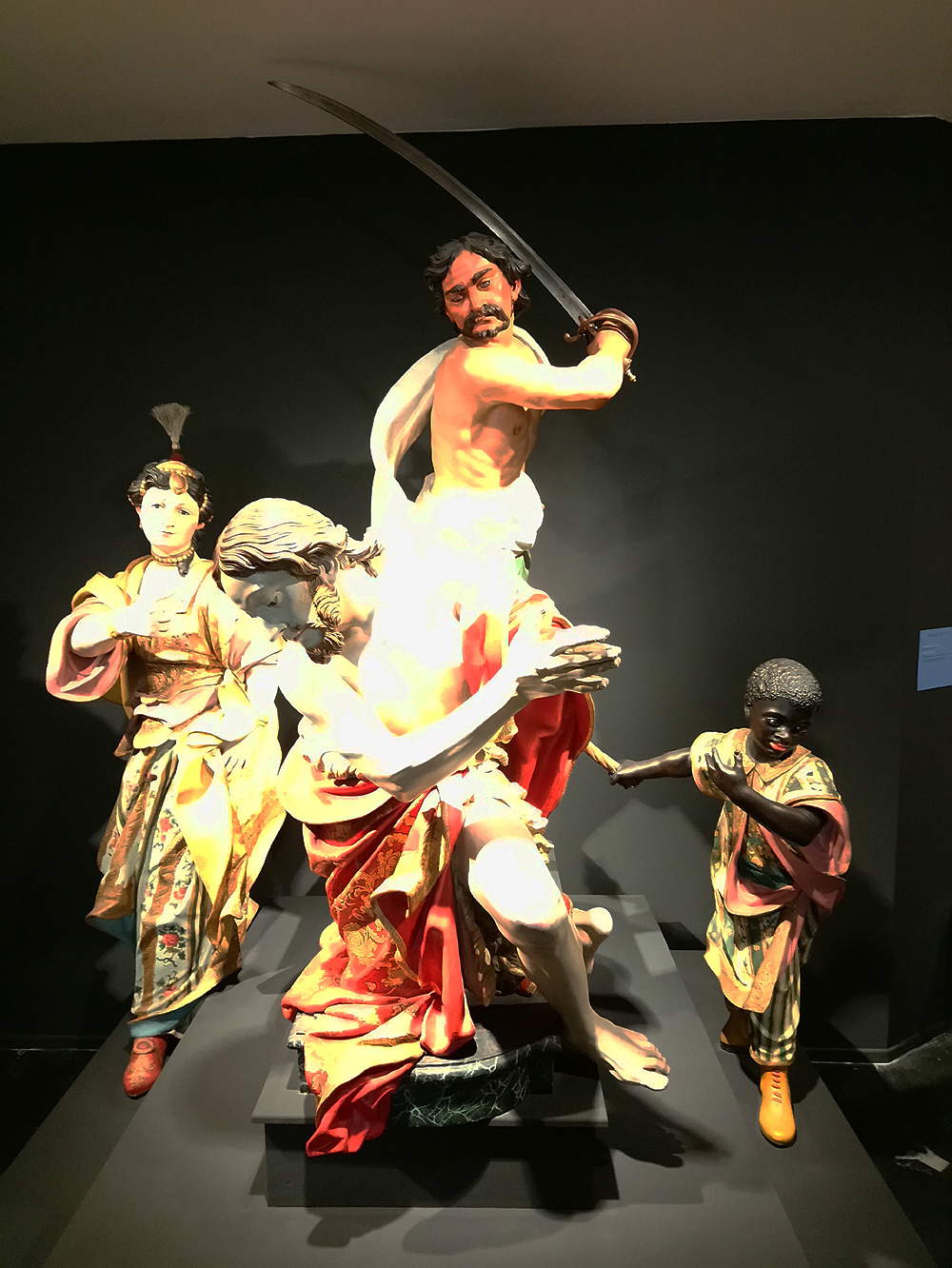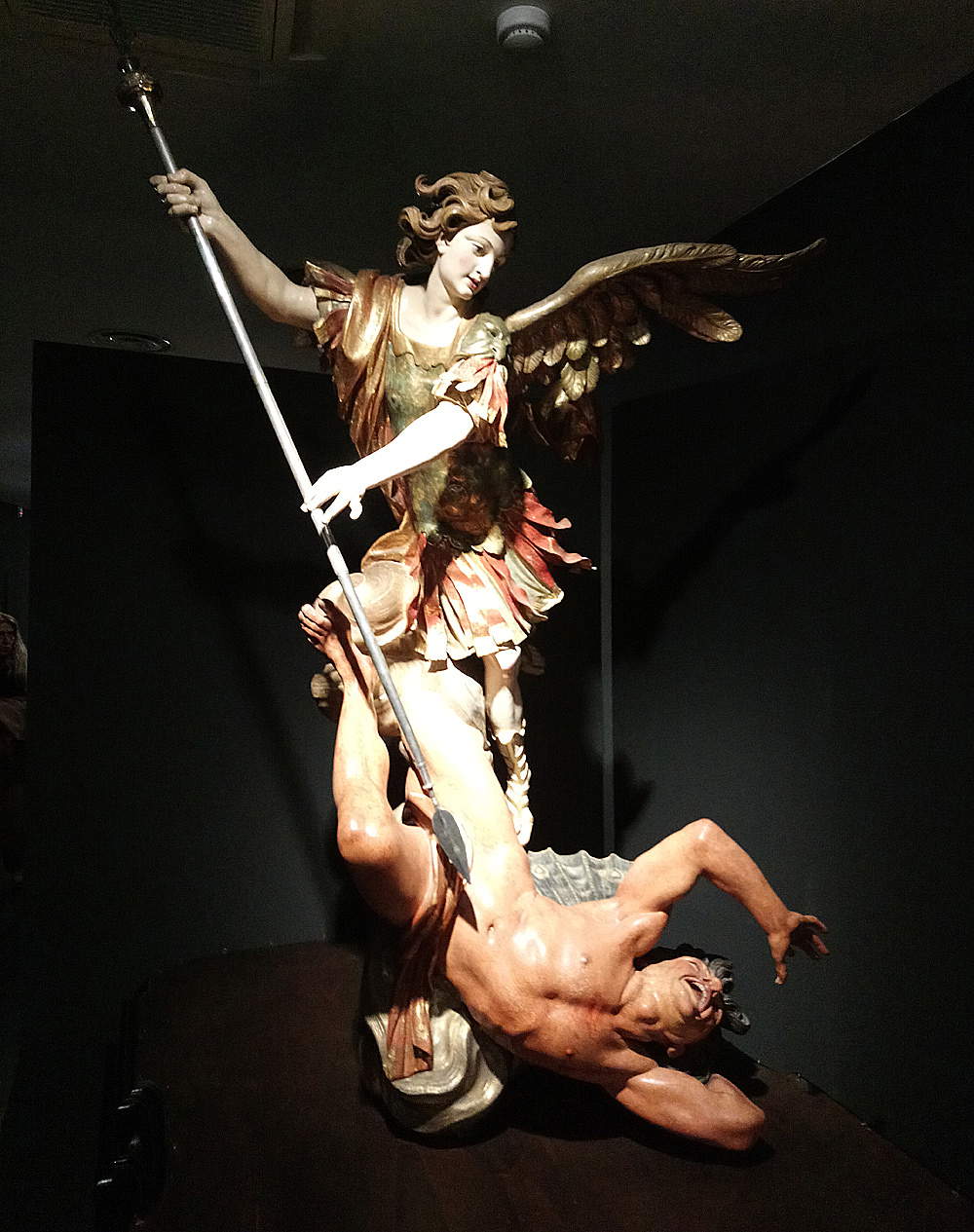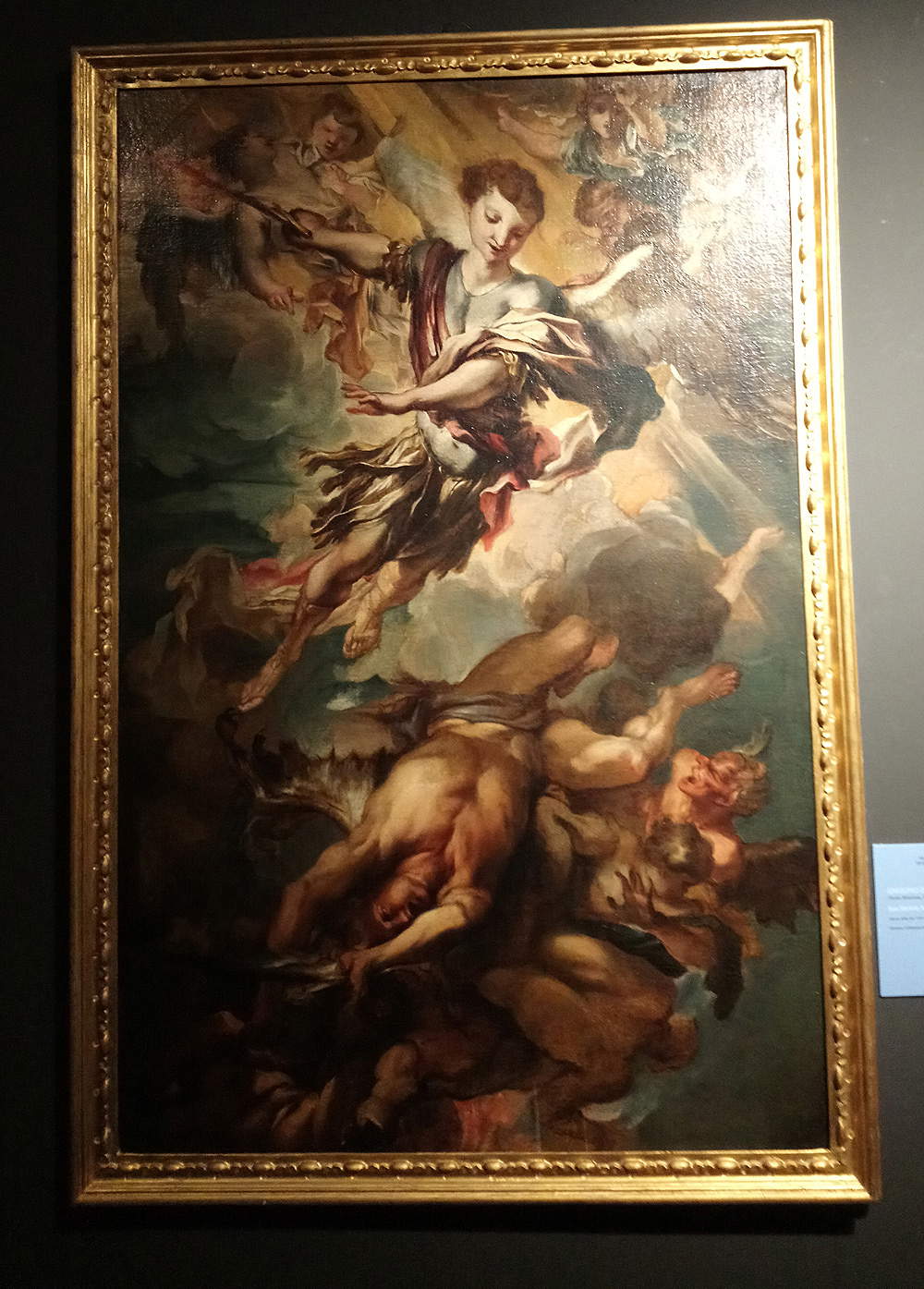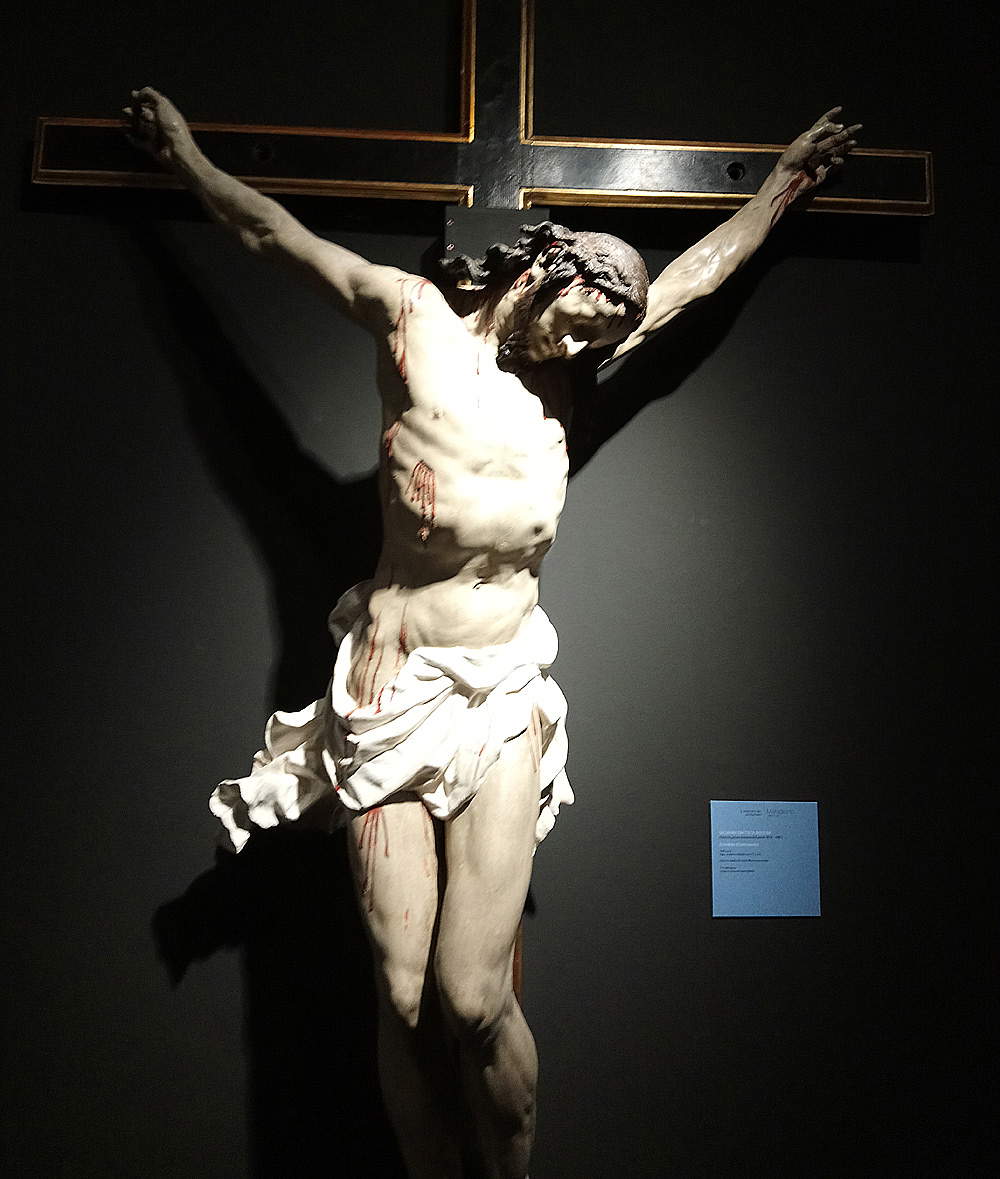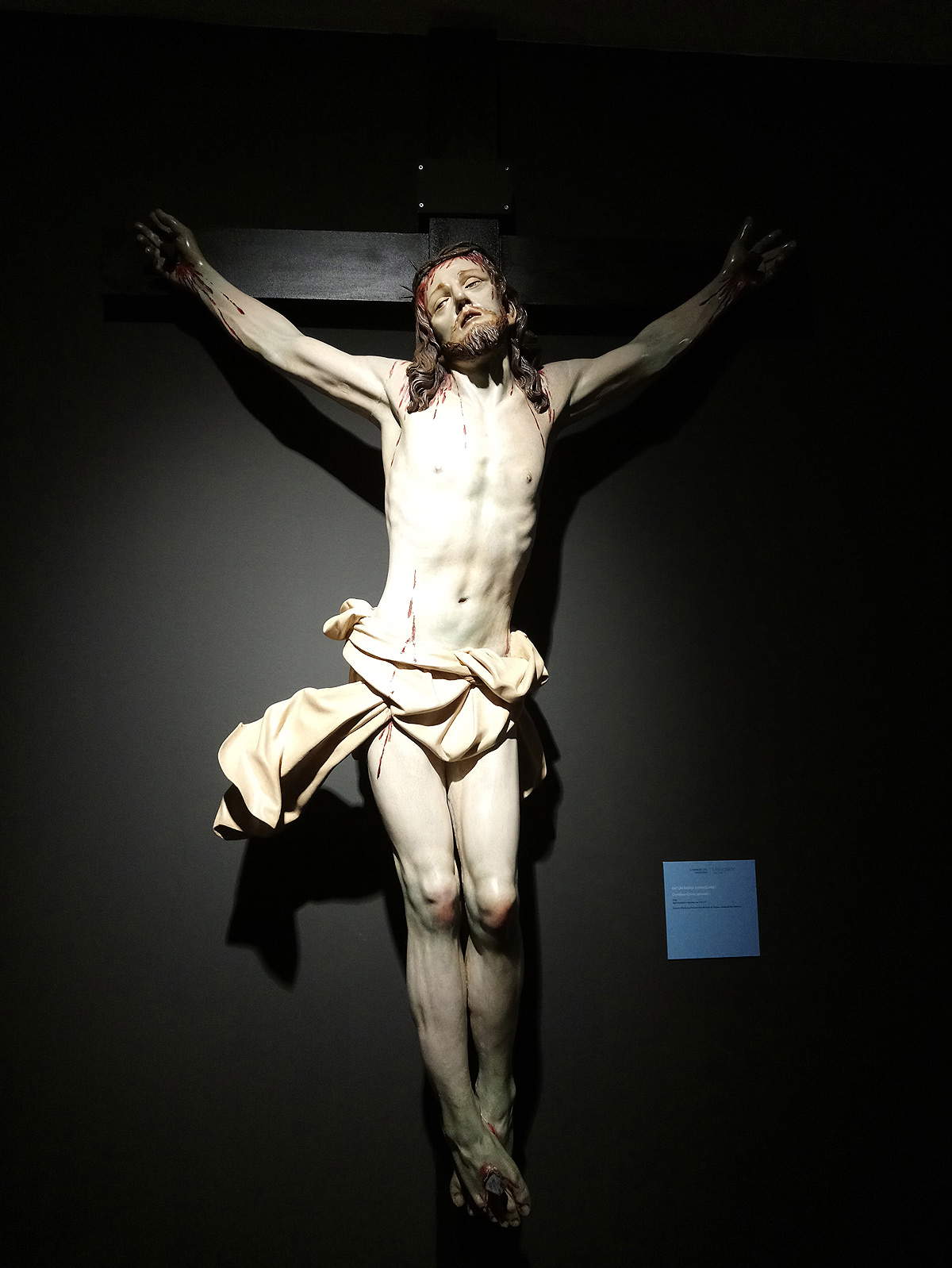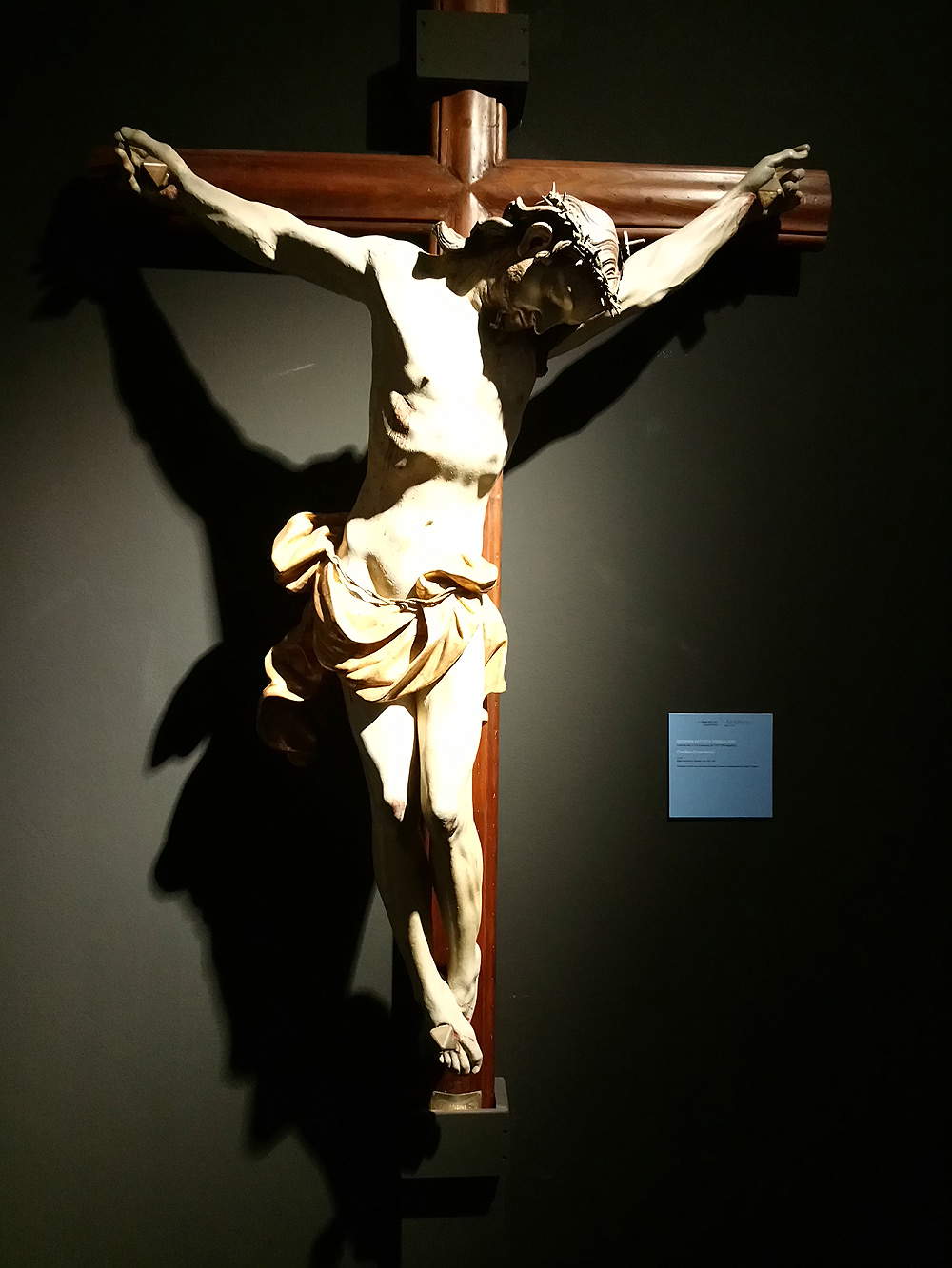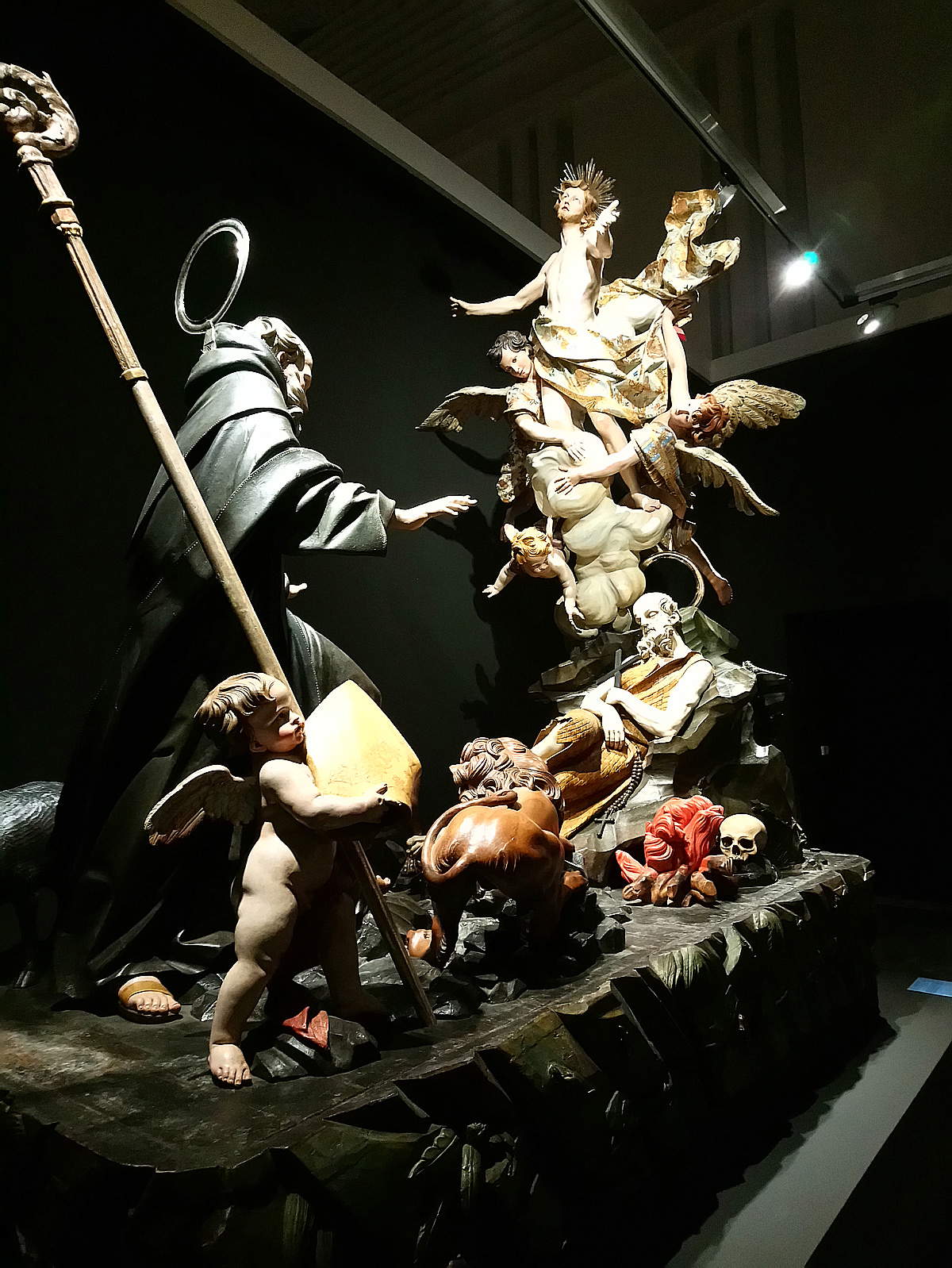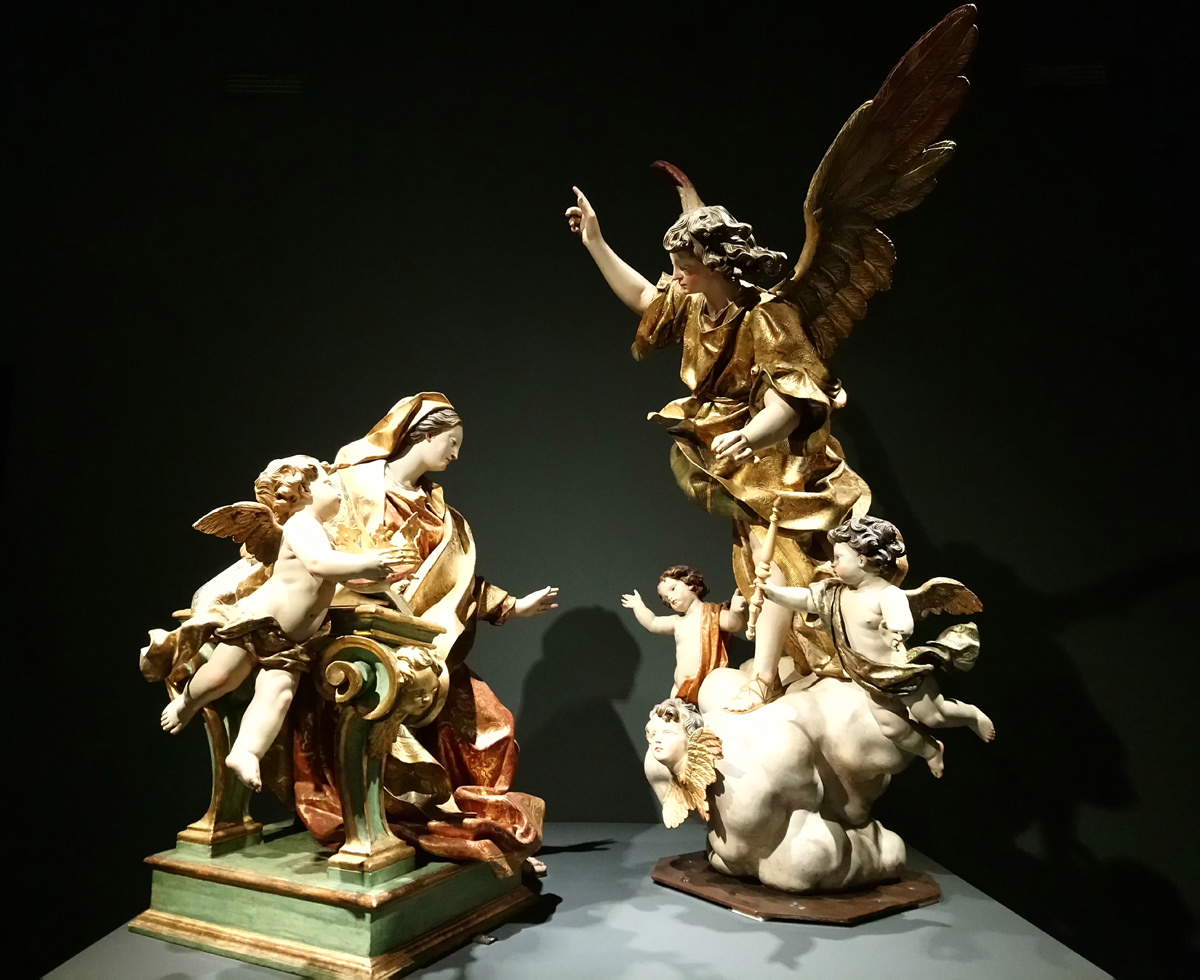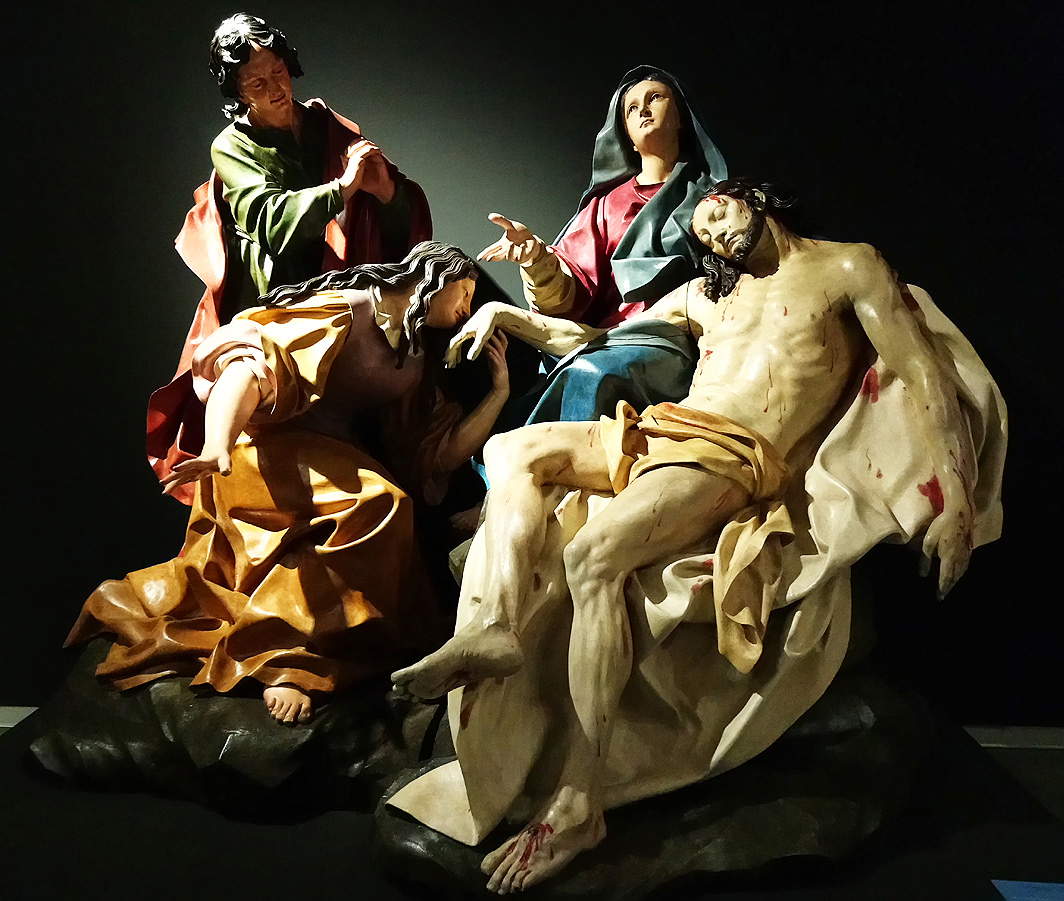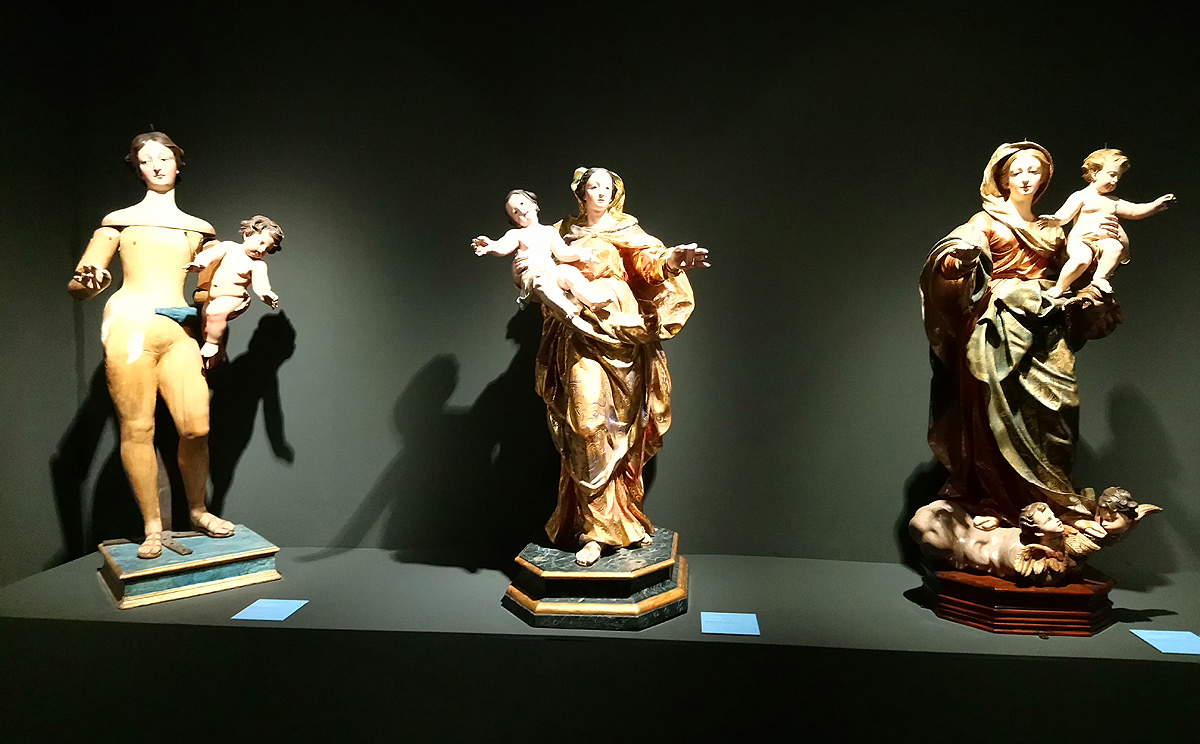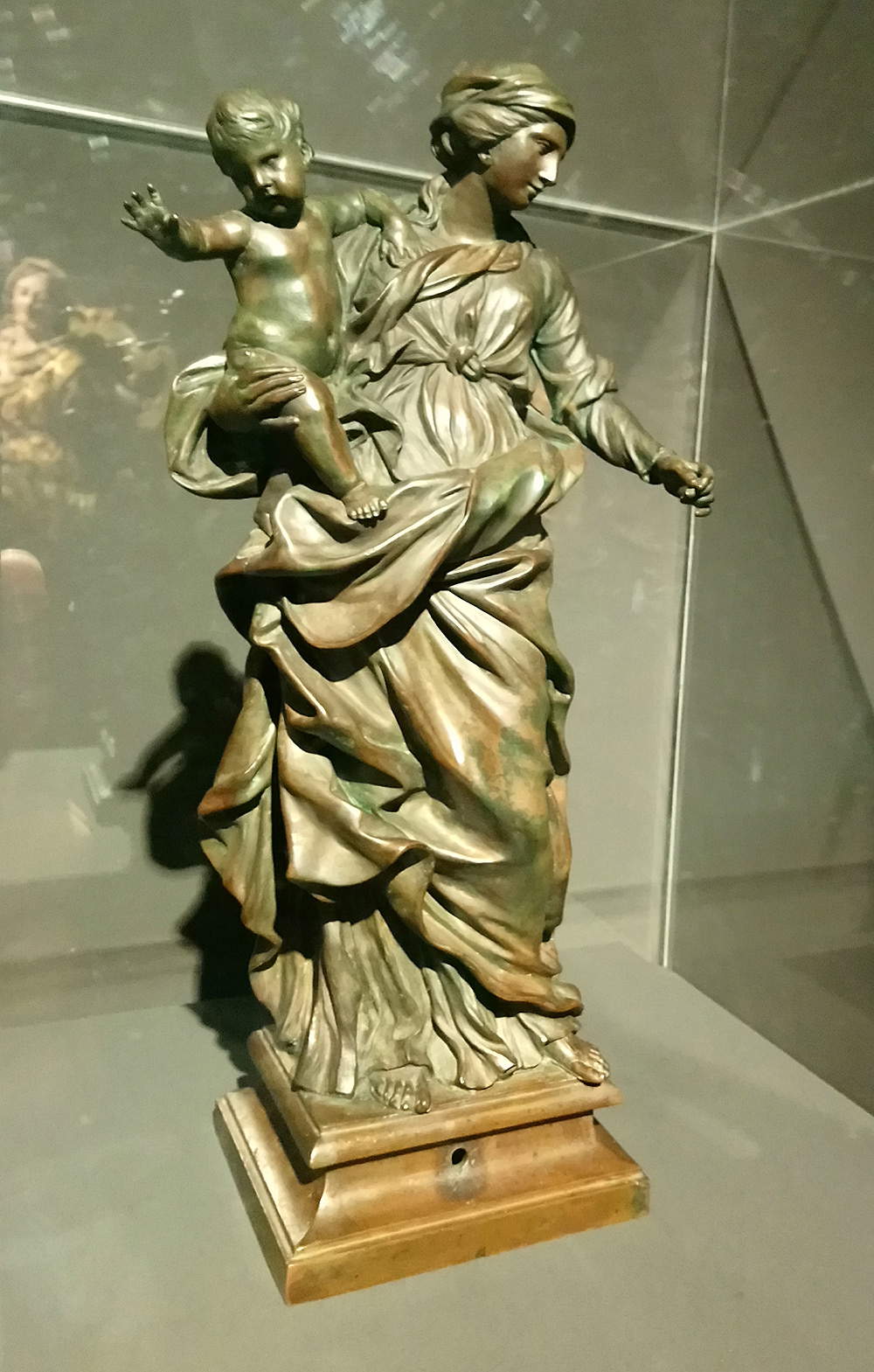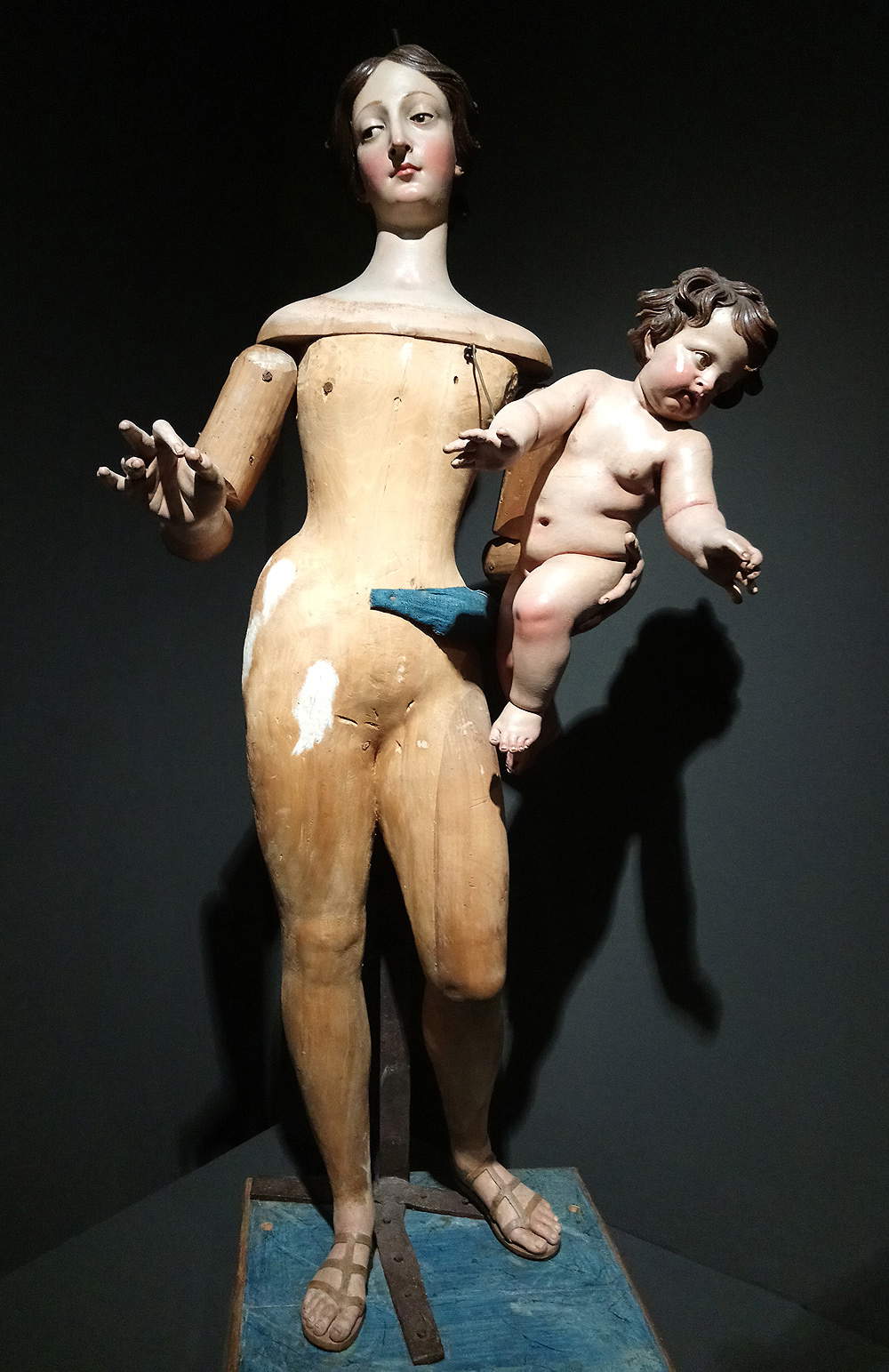by Federico Giannini (Instagram: @federicogiannini1), published on 30/12/2018
Categories: Exhibition reviews
/ Disclaimer
Review of the exhibition 'Maragliano 1664-1739. The Spectacle of Wood Sculpture in Genoa' in Genoa, Palazzo Reale, November 10, 2018 to March 10, 2019.
The name ofAnton Maria Maragliano (Genoa, 1664 - 1739) will say little to many living outside Liguria. The fame of this sculptor is mostly confined to Genoa and its environs, and past Ventimiglia and Luni (although, more accurately, it would be necessary to speak of Sanremo and Sestri Levante, respectively the western and eastern limits of his presence in the region) it also becomes an arduous task to find his works: the vast majority of his production is, in fact, still kept in the churches, oratories, palaces and museums of this strip of land squeezed between the sea and the Apennines. It might seem singular that such a great artist, to whom this year the Palazzo Reale in Genoa is devoting its first monographic exhibition (it is entitled Maragliano 1664-1739. The spectacle of wood sculpture in Genoa, curated by Daniele Sanguineti under the direction of Luca Leoncini), is so little known beyond regional borders. Not least because there is no traveler who, having come to Liguria, has not stumbled upon some of his work, and often when one is confronted with a wooden sculpture by Maragliano one is moved to awe: Maragliano was a genius of the Baroque, he was an extremely receptive personality, he was able to draw cues from painters (above all Domenico Piola), he was able to grasp the essence of Bernini’s art and interpret it with a highly theatrical yet strongly naturalistic language that aspired to appeal to an audience that was as wide as possible, was able to benefit from collaboration with a marble altar specialist such as Jacopo Antonio Ponzanelli (Massa, 1654 - Genoa, 1735), so that his sacred theaters were among the most scenic of the time.
Yet despite such credentials, Maragliano still remains virtually unknown outside his homeland. A number of factors played to his disadvantage: first, that he never moved from Genoa for the duration of his career. Maragliano was an artist firmly rooted in his region, and we can even assume that he never traveled outside Genoa (for that matter, there are no documents left to us that can attest to this, and we have no grounds for assuming sojourns outside the patriot borders): his style was formed on examples that he had at his disposal in the city, but which were evidently sufficient for him to reach very high results of originality. Ligurian were thus his masters, Ligurian his points of reference, but Ligurian was also his clientele, and of course Ligurian his heirs. Think, above all, of his patrons: much of Maragliano’s work was destined for parishes and confraternities, and consequently the reach that such a parterre could guarantee to his art could only be limited (although, conversely, it ensured his widespread diffusion throughout the territory). It is then true that his works reached as far as Spain (Genoa has been a city of exchange and meeting of different cultures for centuries), but these were sporadic cases. Moreover, his works were largely intended for an extremely practical function: they were to decorate chapels, or to be carried in processions. And if one’s mind runs to processions, one cannot help but reason that Maragliano’s works had to speak the language of those who would pray or venerate them, and it was almost always a language perceived as popular and far from the sensibilities of the cultured people who traveled. Finally, and perhaps crucially, it must be considered that wooden sculpture, over the centuries, has always enjoyed less prominence and less attention than marble sculpture, which was considered a sort of nobler sister.
Indeed, the rediscovery of the art of wood is recent, and in the catalog of the Palazzo Reale exhibition, Luca Leoncini presents its stages, in Italy and around the world: the first pioneering attempts to set up a discourse on wood sculpture date back to the 1950s, when Ferdinando Bologna and Raffaello Causa curated an exhibition on Wooden Sculpture in Campania (1950), followed closely byAncient Wooden Art in Liguria edited by Pasquale Rotondi (1952) and an exhibition on Wooden Sculpture in Friuli (1956). These were attempts that had little follow-up, however, since it was not until fifty years later that they returned to the subject: to pick up the thread again, the exhibition The Beauty of the Sacred in Arezzo (2002), an in-depth study devoted to medieval polychrome sculpture, which was followed by the 2004 Sacra Selva (on Ligurian wooden sculpture between the 12th and 16th centuries, curated by Franco Boggero and Piero Donati) and the exhibition of Masters of Wooden Sculpture in the Duchy of the Sforza family (2005), moving through the important monograph on a great contemporary of Maragliano, the Venetian Andrea Brustolon(Andrea Brustolon, the “Michelangelo of wood” in 2009), to the important review that, in 2016, the Uffizi dedicated to 15th-century wooden sculpture in Florence. More timid was the international rediscovery, which Leoncini traces back to a fifteen-year period with the exhibition The Sacred Made Real (at the National Gallery in London between 2009 and 2010, on seventeenth-century Spanish sculpture): perhaps due to the fact that, the scholar suggests, wood sculpture from the Mediterranean area is very distant from the “cultural setting” of the Anglo-Saxon public, which is refractory to “too explicit manifestations of carnality exhibited, particularly in religious scenes.” The exhibition at Palazzo Reale, set up in the spaces of the Teatro del Falcone, thus represents the most recent chapter in a slow but rich and important evolution (also because an exhibition of wood sculpture is almost always an occasion for reconnaissance in the area, as well as a harbinger of new discoveries), and being the first monographic exhibition on Maragliano it is also the first attempt to present to a wide audience a sculptor of exceptional stature, for a long time considered a local artist, rather than an extraordinary protagonist of the late Baroque.
 |
| A room from the exhibition on Anton Maria Maragliano in Genoa, Palazzo Reale |
 |
| A room from the exhibition on Anton Maria Maragliano in Genoa, Palazzo Reale |
 |
| A room from the exhibition on Anton Maria Maragliano in Genoa, Palazzo Reale |
And like any monographic exhibition that aspires to excellence, the exhibition on Maragliano opens with a timely reconstruction of the context. In this case, the journey begins with woodcarving in Genoa before Maragliano: it starts in 1645, so twenty years before Maragliano was born, and eight years after the Madonna was proclaimed Queen of Genoa. The solemn proclamation of 1637 kicked off the production of a series of images of the Virgin in which a sculpture made by Giovanni Battista Bissoni (Genoa, first decade of the 17th century - 1657) for the church of San Marco in Civezza (Imperia) is also included: it was an almost slavish replica of the image that Bissoni himself had sculpted precisely in 1637, based on a design by Domenico Fiasella (Sarzana, 1589 - Genoa, 1669), on the occasion of the ceremony (today the work is preserved in Voltri). Bissoni was the greatest of wood sculptors in Genoa in the mid-seventeenth century, and although the Madonna Regina di Genova, as an official commission, reveals a rather restrained and traditional language, it is a work that continues the research begun by Giovanni Battista’s father, Domenico, aimed at radically renew ing Genoese wooden sculpture to bring them up to date with a higher naturalism (evident, moreover, even when observing the Regina di Genova) that was also intended to have eminently narrative purposes. The latter feature is not appreciated in the work that opens the exhibition, but observing an achievement by a pupil of Giovanni Battista Bissoni, Marco Antonio Poggio (Genoa, 1611? - Spain, before 1674), the Beheading of the Baptist, one can well understand what outcomes the woodcut artists were aiming for at the time: the scene is caught in a very precise moment, the executioner pulls his arm back to deal the fatal blow with his sword, the saint serenely awaits his fate, and Salome smugly points to the Baptist’s end. All almost with excess of ornamentation (one need only observe her dress). This is a now fully Baroque, theatrical, engaging group, oriented toward Rome (Poggio probably visited the capital of the Papal States). Alongside works such as these, however, was a more traditional production: in the exhibition we have the example of the Madonna of the Rosary by Giuseppe Maria Arata (Genoa, 1658-after 1715), moreover referred to by Carlo Giuseppe Ratti as Maragliano’s master: it is a work that does not deviate too much from conventional patterns.
A brief interlocutory section, with quick documentary reconnaissance, then presents the stages of Maragliano’s education: we know him, at the age of sixteen, a pupil of Giovanni Battista Agnesi, who was the husband of Anton Maria’s maternal aunt and brother-in-law of Filippo Parodi (Genoa, 1630 - 1702), the leading Genoese sculptor of the time, with whom Agnesi perhaps made a sojourn in Rome, where at the time a champion of carving such as Johann Paul Schor was working (on these very pages we have had occasion to explore the links between Parodi and Schor) and where the example of Bernini and Algardi was clearly alive. All situations that, in various ways, would form the substratum on which sedimented the art of Maragliano, who in his early twenties was already an independent and, above all, proud artist: the exhibition displays the plea with which, in 1688, the 24-year-old Anton Maria asked the Senate of the Republic of Genoa for exemption from the obligation to register in the art of “bancalari” (i.e., carpenters: wood sculptors were in fact required to join this guild) because, the artist argued, wood sculpture is among the liberal arts “the noblest even in comparison with painting.” A request that somehow had to be fulfilled, since Maragliano never joined the carpenters’ chamber. However, it is necessary to wait until 1694 to find his first documented work: it is the Saint Michael Archangel for the brotherhood of the same name in Celle Ligure, a work to explain which, Sanguineti points out, “nothing analogous can be resorted to, if not by abandoning the field of wooden sculpture and crossing those of painting and marble sculpture.” The “suave flight” of St. Michael who, with elegant snap, grasps the spear (moving it only with his fingertips!) to defeat the Lucifer who is already succumbing with a desperate cry, has illustrious precedents that the exhibition, in one of its highest moments, offers to the visitor to make clear the reminders of Maraglian’s first documented masterpiece: the angel’s posture replicates that of an altarpiece by Gregorio De Ferrari (Porto Maurizio, 1647 - Genoa, 1727) executed for the Imperial Chapel in Santa Maria delle Vigne; that of the devil is punctually matched in a drawing by Domenico Piola (Genoa, 1628 - 1703) now in the Gabinetto dei Disegni e delle Stampe in Palazzo Rosso, the manner in which the saint grasps the spear is quite similar to what the archangel shows in another Piola house drawing, and the devil’s belligerent scream relates to theAnima dannata by the Sicilian ceroplast Giovan Bernardo Azzolino (Cefalù, c. 1572 - Naples, 1645), then in the Doria collection, well-known in city artist circles, and itself a descendant of Bernini’s homologous and celebrated work.
 |
| Giovanni Battista Bissoni, Madonna Regina di Genova (1645; carved, painted and gilded wood, 155 x 90 x 90 cm; Civezza, church of San Marco) |
 |
| Marco Antonio Poggio, Beheading of St. John the Baptist (c. 1660-1665; wood, carved, painted, and gilded, eyes in glass paste, 290 x 193 x 300 cm; Genoa, Sestri Ponente, Oratorio Morte e Orazione) |
 |
| Giuseppe Maria Arata, Madonna of the Rosary (1702-1704; wood, carved, painted, and gilded, Madonna’s eyes in glass paste, 155 x 60 x 60 cm; Rapallo, San Pietro di Novella, San Pietro) |
 |
| Anton Maria Maragliano, San Michele Arcangelo (1694; wood, carved, painted and gilded, 170 x 209 x 173 cm; Celle Ligure, San Michele Arcangelo) |
 |
| Gregorio De Ferrari, Saint Michael Arch angel (oil on canvas, 110 x 72.5 cm; private collection) |
 |
| Giovanni Bernardo Azzolino, Anima dannata (wax, 7.5 cm; Naples, Museo Nazionale di Capodimonte) |
 |
| Comparison between Maragliano’s St. Michael and De Ferrari’s St. Michael |
The St. Michael the Archangel already reveals the stylistic signature that will form the basis of Maragliano’s sculpture: the innovations made by the Genoese sculptor "granted the faithful the definitive response to their expectations: the unprecedented ’hyperrealism’ of the figures and the spectacularity of the processional chests accentuated the pathetic aspects already inherent in the sculptural three-dimensionality, ensuring a more stringent emotional identification between audience and simulacrum" (Valentina Borniotto). Suffering saints praying, saints frozen with amazement before ecstatic apparitions, saints suffering the torments of martyrdom: these are the figures that, devoted to the most vivid and often crude expressionism, populate Maragliano’s art. The Genoese exhibition presents side by side, one next to the other, the San Pietro d’Alcantara and the San Pasquale Baylon made for the Franciscans of Santa Maria della Pace: it was precisely the Franciscans who were among Maragliano’s most assiduous clients, perhaps precisely because of the high degree of realism the sculptor was able to touch. The two saints for Santa Maria della Pace, dating from the beginning of the 18th century, are clear proof of this: their attitudes, their wispy and emaciated faces, and their hair styles that respect traditional iconography (bald St. Peter of Alcantara, and with thick, straight hair Pasquale Baylon: those that Maragliano gives them seem almost unkempt) achieve an intense naturalism in line with the requests of the Franciscans, who displayed the two statues on occasions of solemn festivities.
Next, the back corridor of the Teatro del Falcone, on the walls of which crucifixes have been arranged on both sides for the occasion, introduces the audience to the first thematic exploration of the exhibition: the renewal of the iconography of the crucifix. Carlo Giuseppe Ratti, in his biography of Maragliano, states that “his first works were certain Images of Crucifixes, in the structure of which he had already acquired much skill, because of the accurate observations and frequent copies made from the very rare Crucifix, Work of Bissoni, which is exhibited in the Church of the Holy Spirit at the PP. Somaschi.” The work by Bissoni (in this case, it is Giovanni Battista) to which Ratti alludes is on display in the exhibition: it is the Crucifix made around 1643 for the Chapel of the Cross in Santo Spirito, commissioned by the Spinola family, which held the juspatronage. Raffaele Soprani had also spoken of this Christ on the Cross, calling it “the most beautiful of the beautiful.” it was, in fact, a new image, a Crucifix that intended to combine the vivid naturalism of earlier enterprises, such as Domenico Bissoni ’s Cristo spirante (Bissone, before 1574 - Genoa, 1637), which describes with heartfelt and participating patheticism the suffering of Jesus in agony on the cross, to solemn and to some extent classicist impulses, stimulated by an interest in Algardi’s language as well as by texts already present in the city (above all Federico Barocci’s Christ still preserved in the Cathedral of San Lorenzo, in the place for which it was painted: the Senarega Chapel).
It is a very young Maragliano who is confronted with the Christ of Giovanni Battista Bissoni: a very recent research by Massimo Bartoletti (it is from this year) has proposed to fix, on the basis of information deduced from an inventory, at 1689 the date of execution of Maragliano’s Crucifix in the church of Santissima Annunziata in Spotorno. It is a model that faithfully echoes Bissoni’s work (even, the folds of Christ’s loincloth follow the same course): only, Maragliano’s Christ is turned to the other side, in a mirror-image manner to Bissoni’s. In later realizations, Maragliano proved to break away from his points of reference, proposing, as anticipated, a new iconographic type, with a Christ framed in the scheme of an increasingly sinuous layout (this is the case, for example, of the Crucifix in the Church of the Nativity of Mary Most Holy in Bogliasco, or of that of Villa Faraldi in Imperia) but which does not renounce a continuous search for veracity that verges on virtuosity, especially if one observes the details of the anatomies (the way Maragliano modeled the muscles denotes a thorough knowledge of the human body) or those of the face (and particularly intense, in this case, is the expression of the Christ spirant of the church of San Michele in San Michele di Pagana, near Rapallo: this is one of his last works). Maragliano’s experiments were highly successful, if his pupils stuck, albeit with less happy results, to the schemes set by the master: among the crucifixes on display in the exhibition we can mention, for example, the one by Giovanni Battista Maragliano (news from 1714 to 1737), executed for the oratory of Santa Chiara in Bogliasco and with which the son of Anton Maria proposes a sober interpretation of his father’s innovations.
 |
| Anton Maria Maragliano, Saint Paschal Baylon and Saint Peter of Alcantara (c. 1700-1705; wood, carved, painted, and gilded, eyes in glass paste, 108 x 78 x 73 cm and 121 x 79 x 43 cm, respectively; Genoa, Nostra Signora della Visitazione) |
 |
| Giovanni Battista Bissoni, Crucifix (c. 1643; carved and painted wood, 177 x 116 cm; Genoa, Basilica of Santa Maria Immacolata) |
 |
| Anton Maria Maragliano, Crucifix (1689; carved and painted wood, 185 x 120 cm; Spotorno, Santissima Annunziata) |
 |
| Anton Maria Maragliano, Crucifix (1738; carved and painted wood, 170 x 97 cm; Rapallo, San Michele di Pagana, church of San Michele) |
 |
| Giovanni Battista Maragliano, Crucifix (1714; carved and painted wood, 120 x 80 cm; Bogliasco, Santa Chiara) |
A brief parenthesis on the design of the large wood carvings (drawings and models are on display) leads the visitor to the highlight of the exhibition, which first opens with a section devoted to the “grand theater of the casacce.” in Genoa, the so-called casacce were associations of several confraternities in the same oratory, each named after a different saint (although the confraternities that constituted them continued to revere their patron equally), and which, Fausta Franchini Guelfi explains in the catalog essay devoted precisely to the casacce, “publicly manifested their relevance in the processional ritual: it is in fact the procession [...] to represent the most explicit and lively expression of devotional needs, of social conflicts, of the need to reaffirm, in the context of a territory and a system of relationships, one’s existence as a group, reaffirming one’s prestige also with the magnificence of the apparatus.” And of such magnificence, Maragliano was the most innovative and striking interpreter: his casacce (the term used in Genoa to designate the processional machines, the large simulacra carried on the shoulders of members of the confraternities during festivities) reached unusual heights of spectacularity, which the exhibition intends to evoke by also availing itself of stagings that do not skimp on the matter of scenographic taste (gloomy environments, casacce displayed isolated from each other and placed at a height roughly similar to the height they must have been when they were transported). The need of the casacce was to strongly impress the audience of the processions (as well as the members of rival casacce: often the processions were even the cause of violent clashes) with imposing machines, devoted to the most dramatic theatricality. To be represented were scenes from the lives of the titular saints of the casacce: these were often martyrdoms or visions, moments narrated according to a strict adherence to hagiographies. Maragliano was not interested in providing his own interpretation of the sacred texts: what was important to him, if anything, was to represent the texts according to a spectacularity never before experienced by others. Maraglianesque novelties thus resided in his dense, direct, dramatic, exciting, imaginative language, often capable of descending into the abysses of the grotesque, apt to give form to the late Paleotian instances of excitement of the minds of the onlookers. Today, most of Maragliano’s coffers have lost their original function, but to get an idea of the feelings they triggered in those who observed them during processions, it is necessary to imagine them being carried on the shoulders amid noisy and vociferous crowds through the streets of Genoa. Among the most powerful Maraglianesque chests is certainly the St. Anthony Abbot Contemplating the Death of St. Paul the Hermit, carved between 1709 and 1710 for the Brotherhood of St. Anthony Abbot and St. Paul the Hermit and now in the Oratory of St. Anthony Abbot in Mele: an imposing processional group nearly four meters high, celebrated by Ratti (“I frankly assert this to be the best Work that has come out of the scarpelli of Maraggiano”), and figuration among the most complex conceived by the Genoese artist, as well as very rich, with the protagonist, Anthony Abbot, seeing Saint Paul the Hermit die and his soul elevated to heaven by a swarm of angels, while another putto, below, holds the mitre and pastoral staff of Anthony Abbot. Attention to detail is very high, and mimesis invests even the base of the group, which imitates the rocky environment on which the scene takes place. Voted to wonder is also theAnnunciation of 1722, a work of maturity with which Maragliano reaches greater refinement and which “marks on the part of the sculptor the conquest of a new freshness of execution, under the banner of extreme formal elegance, unique in the contemporary Genoese panorama” (Daniele Sanguineti): achievements that would be emphasized in the later groups, such as the Martyrdom of St. Catherine, imagined in the guise of a scenic pyramid structure with, at the apex, angels rushing to the aid of the saint suffering the tortures of her torturers (the scene is far from stark, however: the late Maragliano experiments with a style that combines drama and grace).
And if much of Maraglianesco’s theater took place in the street, no less significant was that conceived for the interiors of chapels: in fact, the production of chests was flanked by that of altar groups. The artist, looking on the one hand at the compositions of the Frenchman Honoré Pellé (Gap, 1641 - Genoa, 1718), on the other at the marble splendors of Filippo Parodi, and collaborating, as anticipated, with the Carrarese Ponzanelli whose task it was to design the apparatuses that would accommodate the statues, succeeded in creating total works of art where the protagonists were not only his characters, but also the backgrounds painted by the painters, the light that was exploited in a narrative sense, and the architecture that framed the compositions. It is not easy to realize this in the exhibition (the curators’ invitation is, in fact, to go also to the discovery of the works distributed in the city, many of which are still in their original locations), but some groups, especially those on the theme of the Passion of Christ, well render the idea. These include the Deposition from the Cross, which brings to three-dimensional life a Cambiasque precedent in painting (today, moreover, we no longer preserve the original arrangements, because the church that housed the work was destroyed at the time of the Napoleonic suppressions), or the highly praised Pieta all played out on diagonals and thus almost animated by movement.
In the closing bars, the exhibition investigates the evolutions undergone by representations of the Madonna in seventeenth-century Genoa: a renewal under the banner of Baroque exuberance, albeit somewhat toned down compared to what was happening at the same time in Rome, which was spurred on by the presence in the city of a great sculptor such as Pierre Puget (Marseille, 1620 - 1694) and, again, by the activity of Filippo Parodi, who in Genoa was a great popularizer of the manners ofAlessandro Algardi, who is also present in the exhibition with a bronze Madonna and Child (consider that Algardi was primarily a sculptor in marble) probably known in Genoa, since it is a model that several Genoese sculptors replicated. Maragliano was the first to translate into wood (and thus to renew a field that still remained tied to traditional stylistic features) the suggestions coming from marble, in search of a plasticism and softness unheard of in Genoese wooden sculpture. Madonnas in movement, graceful and adorned with elegantly ornate robes, such as the Madonna of the Rosary from Celle Ligure, whose cloak designs elegant volutes that fall forming almost unnatural folds, or the very special Madonna del Carmine, entirely painted white to simulate a marble sculpture, and where the fluttering of the drapery and the refined gesture of the right hand with the middle finger and thumb joined return (we have to imagine Our Lady of Mount Carmel as she holds the scapular, just as the same gesture, in Our Lady of the Rosary, is functional in displaying the rosary to the faithful). There is also no shortage of curiosities such as the mannequin of Our Lady of Mount Carmel in the basilica of San Maurizio in Imperia: the Madonna had to be clad in real clothes. Motifs that would return, albeit with greater sobriety, in the works of the heirs, with which the Palazzo Reale exhibition ends: among others, the Madonna of the Rosary by Agostino Storace (Genoa, second decade of the 18th century - after 1793), which re-proposes Maraglianesque schemes albeit more compassed, and even the counterpart work by Giovanni Maragliano (Genoa, c. 1710 - 1777), which, with its draperies arranged almost geometrically, veers toward formal abstraction.
 |
| Anton Maria Maragliano, Saint Anthony Abbot Contemplates the Death of Saint Paul the Hermit (1709-1710; carved, painted and gilded wood, glass paste eyes, 360 x 195 x 359 cm; Mele, Oratory of Saint Anthony Abbot) |
 |
| Anton Maria Maragliano, Annunciation (1722; carved, painted, and gilded wood, eyes in glass paste, 190 x 162 x 145 cm; Savona, oratory of San Domenico and Santissima Annunziata) |
 |
| Anton Maria Maragliano and workshop, Martyrdom of St. Catherine (1735-1736; carved, painted and gilded wood, eyes in glass paste, 235 x 157 x 270 cm; Sestri Levante, San Pietro in Vincoli) |
 |
| Anton Maria Maragliano, Deposition (c. 1720-1725; carved and painted wood, eyes in glass paste, 200 x 290 x 140 cm; Genoa, Nostra Signora della Visitazione) |
 |
| Anton Maria Maragliano, Pietà (c. 1710-1715; carved and painted wood, eyes in glass paste, 160 x 220 x 144 cm; Genoa, San Filippo Neri) |
 |
| Some of Anton Maria Maragliano’s Madonnas in the exhibition (right, Madonna of Celle Ligure) |
 |
| Alessandro Algardi, Madonna and Child (lost-wax cast bronze, 48.5 x 26 x 15.5 cm; Urbino, Galleria Nazionale delle Marche) |
 |
| Anton Maria Maragliano, Madonna del Carmine (c. 1725; wood carved and painted to simulate marble, 130 x 85 x 65 cm; Castellazzo Bormida, San Carlo) |
 |
| Anton Maria Maragliano, Madonna del Carmine (c. 1700-1715; carved and painted wood, eyes in glass paste, 168 x 50 x 50 cm; Imperia, Basilica of San Maurizio) |
 |
| Left, Agostino Storace, Madonna of the Rosary (after 1743; carved and painted wood, eyes in glass paste, 140 x 70 x 60 cm; Garbagna, San Giovanni Battista). Right, Giovanni Maragliano, Madonna of the Rosary (before 1750; carved and painted wood, 138 x 77 x 60 cm; Neirone, San Maurizio) |
There is no doubt that the exhibition at Palazzo Reale can be included in the list of this year’s outstanding exhibitions, and not only: the fruit that continues, and to a certain extent crowns, a long-standing commitment by Daniele Sanguineti (who had already begun working on Maragliano in the 1990s, moreover, publishing a substantial monograph on the sculptor in 1998: an important basis for reading the current exhibition, which thus comes exactly twenty years later), the exhibition succeeds in capturing several results of considerable relevance. First and foremost, the underlining of the importance of the figure of Maragliano: it is true that already the aforementioned 1998 monograph, as Leoncini suggests, had restored to the artist an autonomy capable of recognizing his genius and elevating him among the greats of the late Baroque, but a major exhibition was still missing from the roll call, bringing together most of his major works in a path that happily combined philological depth and vocation for popularization. Again, the merit of the exhibition is that of reconstructing the dense weave of Genoese wooden sculpture between the seventeenth and eighteenth centuries with extreme thoroughness: the merit lies in not having presented Maragliano as an isolated talent, but as the most precious germination of a fertile and awake environment. The extension of the discourse to the broader subject of wooden sculpture of the period has allowed for the development of in-depth reflections involving historical, religious, cultural and social as well as artistic aspects, and sometimes leading to unprecedented conclusions: it will be opportune to make a quick mention, in this sense, of the section (of which we have been silent above) of the private Maragliano, within which, moreover, an attributional proposal has been formulated for a group of statuettes from the late eighteenth century, assigned to Pasquale Navone (Genoa, 1746 - 1791), who was among the major Ligurian wood sculptors of the late eighteenth century. In essence, this is an exhibition that will be remembered for a long time to come: set up on the basis of recent research (most of the works that comprise it have been published in the last ten years), it not only makes a substantial contribution to our knowledge of Maragliano, but also stands as an important new chapter in the rediscovery of wood sculpture.
An exhibition, moreover, well accompanied by a full-bodied catalog that represents an indispensable tool for study and in-depth study for those who wish to approach Maragliano’s art or find the most up-to-date findings on his production. Finally, there is also to be emphasized the fact that the general public cannot help but be both fascinated and impressed by Maragliano’s extraordinary machines, also by virtue of the fact that the arrangements have been designed to enhance the grand spectacle of Maragliano’s theater, with the premises of the Falcone Theater exploited to create an itinerary that holds surprises room after room and thus succeeds in the intent of suggesting to the visitor what the effect Maragliano’s sculptures must have been in the relative seventeenth-eighteenth century. This is a task that is far from simple, but it is carried out in an egregious manner, so that the public can imagine, without too much difficulty, the works in their context.
Warning: the translation into English of the original Italian article was created using automatic tools.
We undertake to review all articles, but we do not guarantee the total absence of inaccuracies in the translation due to the program. You can
find the original by clicking on the ITA button. If you find any mistake,please contact us.
